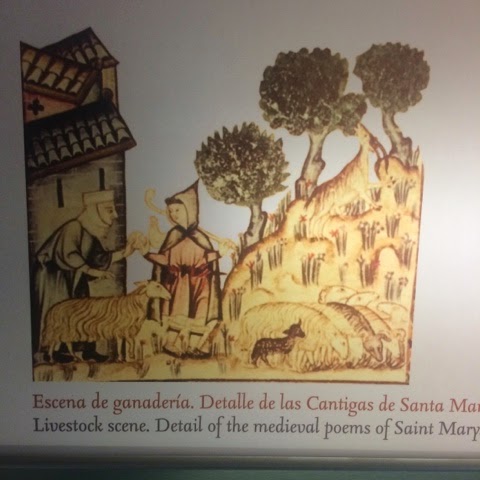When we arrived at our hotel in Cartagena, the clerk was first a little concerned that we were two men, since we had not identified ourselves when booking. Turns out he was worried that we would need two beds since for some reason they had upgraded us to a suite.
We did not mind sleeping in the same bed.
Or enjoying our private terrace.
Or our bathroom with giant jetted tub and a bidet.
Or the view!
Directly across the street was a very modern building housing a very old ruin - the Punic Walls. Hasdrubal, brother of the great Carthaginian general Hannibal, founded the city in the 3rd Century, BC. and named it Qart Hadasht. Cartagena got its present name from the Romans who, having defeated the Punic civilization, named it Carthago Novo - New Carthage. (We've been to Carthage too! It's in Tunisia.)
Here a segment of the wall. It was wide enough that there were rooms inside which housed the soldiers.
And below, a crypt gouged out of the ruins 1800 years later.
Complete with skull and uncrossed bones.
And a mural.
Further into town we toured the Augusteum, Roman precinct under a more recent building. Here's a Roman road (the picture is a lit screen showing how the road might have looked at the time. The Augusteum was a complex devoted to the cult worshipping Caesar Augustus.
A bust of Caesar Augustus.
There was an attempt to show how the Romans might have lived - the floor mosaic is original.
As are these two wall decorations.
And this tiled floor.
Original columns.
The image is a projection, not standing on the column base.
More carved stone.
Fragment of sculpture - life sized.
Cartagena appeared to be proud both of its illustrious past, but also its use of modern architecture to house the ruins. There was a large area of a Roman barrio under this Gehreyesque roof line here.
Four banquet halls were preserved under the roof.
With another Roman Road.
Old, not so old and new.
Wall decorations in one of the banquet halls. The window panes are original Roman remains.
Wall detail.
Across the street was a ruined bath complex.
Under its own modern dome-like structure.
Outside in the streets a statue grouping celebrates the Holy Week participants.
Some lovely modernist buildings.
Near the Seawall was this monument to the victims of terrorism. Child provided to show relative size.
To explore the castle on top of the hill we got to use this modern lift, with projecting walkway to look out at the old bullring built over the Roman amphitheatre. Both are no longer in use.
This castle was used more for exhibits.
Including a special exhibit of works by Michaelangelo. This bicycle...
And she of the enigmatic smile (Not the original - it's still safe in Paris).
A screaming peacock wandered the grounds.
And showed off his prowess.
Of course the views were wonderful.
There were a few representations of the reason for the fort. Helmets for the soldiers.
And chain mail.
Inside one of the museum displays this illustration showing village life.
And below us, the huge, well preserved Roman Theatre.
A few Roman sculptures.
The Roman Eagle of course.
And this was presumed to be a head of Caesar Augustus himself.
More mosaic floors.
And then the Theatre which we got to explore from inside after walking down the hillside from the Castle.
Original column supports.
And a few people wandering the seats for scale.
The backdrop was two stories. We always wonder how they got these huge stones in place.
Rather more prosaic, after our touring we eat. We were surprised to find butter (not margarine) in a squeeze bottle. These Europeans sometimes seem far more innovative with foodstuffs than we North Americans.
We were excited to see this yellow arrow directing us on the Pilgrimage of Santiago de Compostela. Yes, we can start from here too.
Street art is everywhere. Loved this piece fronting an abandoned building space.
And this incrediblemural on a stairwell.
One of the more poignant museums we visited was a bomb shelter built during the Spanish Civil War. Cartagena remained loyal to the Republican government which was opposed by the Nationalists (Fascist) forces led by General Francisco Franco.
This particular shelter was built to house about 5500 people so was probably the largest. The city was bombed because it held the Republican navy fleet which was loyal to the government.
Several posters were displayed.
This one reads, "Our Coasts were defended by our brave sailors".
And here an announcement that Refuges were being constructed so "we will avoid much sadness and we will be stronger"
A photo from the period.
































































Wow, the museum displays of the Cartagena ruins really are spectacular!
ReplyDeleteAt first I thought the chain mail was a knitted sweater. ��